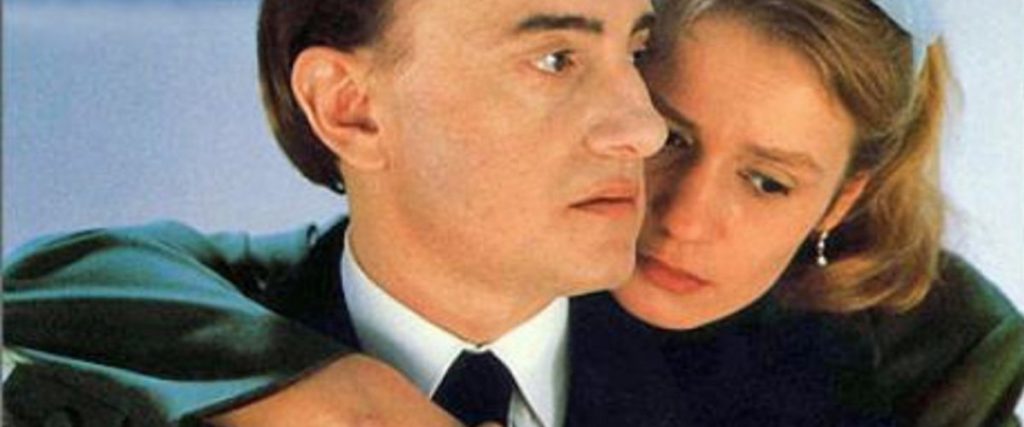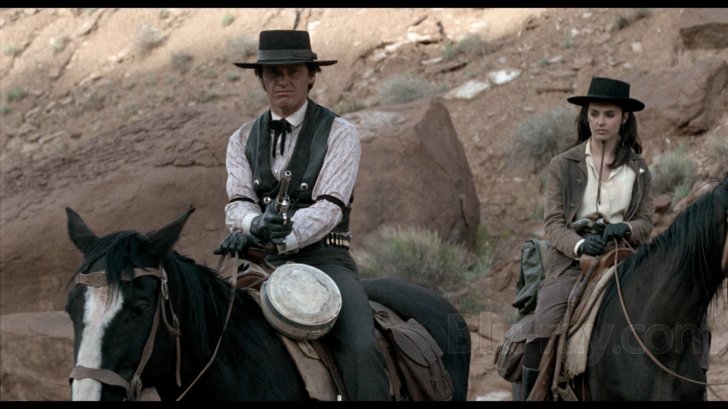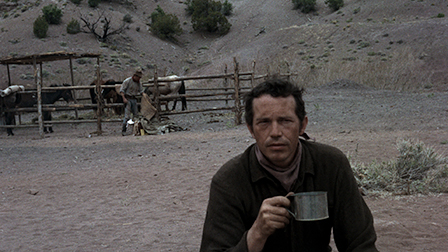THE ROOF OF THE WHALE
From Rouge No. 2 (2004). — J.R.
| The Roof of the Whale aka On Top of the Whale (Hek dak van de Valvis/Le Toit de la baleine, Netherlands/France, 1981) |
||
From Rouge No. 2 (2004). — J.R.
| The Roof of the Whale aka On Top of the Whale (Hek dak van de Valvis/Le Toit de la baleine, Netherlands/France, 1981) |
||
Chantal Akerman’s greatest film — made in 1975 and running 198 minutes — is one of those lucid puzzlers that may drive you up the wall but will keep you thinking for days or weeks. Delphine Seyrig, in one of her greatest performances, plays Jeanne Dielman, a Belgian woman obsessed with performing daily rounds of housework and other routines (including occasional prostitution) in the flat she occupies with her teenage son. The film follows three days in Dielman’s regulated life, and Akerman’s intense concentration on her daily activities — monumentalized by Babette Mangolte’s superb cinematography and mainly frontal camera setups — eventually sensitizes us to the small ways in which her system is breaking down. By placing so much emphasis on aspects of life and work that other films routinely omit, mystify, or skirt over, Akerman forges a major statement, not only in a feminist context but also in a way that tells us something about the lives we all live. In French with subtitles. (JR) Read more
From Rouge No. 2 (2004). — J.R.
| Snakes and Ladders (Le Jeu de l’Oie: La Cartographie, short, France, 1980) |
|
From the Chicago Reader (September 14, 2001). — J.R.
The Vertical Ray of the Sun ***
Directed and written by Tran Anh Hung
With Tran Nu Yen-khe, Nguyen Nhu Quynh, Le Khanh, Ngo Quang Hai, Tran Manh Cuong, and Chu Ngoc Hung.
Last spring I was in Austin, Texas, on a film-festival panel about film festivals with the editor of a film magazine who’s also the author of a book on film festivals. “I don’t like foreign films or academic films,” he told me, a declaration that stumped me at first because it raised two vexing questions: (1) Why link “foreign films” and “academic films” as if the two had something intrinsic in common? (2) Had he seen at least one film from every foreign country in the world that produced movies and made his judgment on that basis?
After pondering other things he said, I came up with what I believe were the correct answers to both questions. (1) Foreign films and academic films were linked for him because both obliged him to think. (2) Of course not; what he meant by “foreign” was simply “not American.” Put these premises together and it’s clear he was saying he didn’t like movies that made him think, which is what non-American movies did — apparently even Bavarian porn, Italian splatter fests, and Crouching Tiger, Hidden Dragon. Read more
Perhaps the most unjustly neglected of Michelangelo Antonioni’s early features, La Signora Senza Camelie (1953) is a caustic Cinderella story about a Milanese shop clerk (Lucia Bose) who briefly becomes a glamorous movie star. One of the cruelest and most accurate portraits of studio filmmaking and the Italian movie world that we have, it’s informed by a visually and emotionally complex mise en scene that juggles background with foreground elements in a choreographic style recalling Welles at times. Though it’s only Antonioni’s third feature, and its episodic structure necessitates a somewhat awkward expositional method, this is mature filmmaking that leaves an indelible aftertaste. In Italian with subtitles. 105 min. (JR) Read more
From the Village Voice (June 1, 1982). — J.R.
SCIENCE: GOOD, BAD AND BOGUS by Martin Gardner. Prometheus, $18.95.
As an old fan of Fads and Fallcies in the name of Science, Martin Gardner’s classic ’50s “study in human gullibility,” I’ve been looking forward to a sequel for quite some time. This collection of 38 skeptical pieces about “pseudoscience” (from Uri Geller to UFOs, by way of ESP) and “eccentric fringes” (such as black holes, catastrophe theory, and talking apes) isn’t that sequel, but it’s the next best thing — an elegant paste-up of articles and book reviews Gardner has written over the past three decades.
Fads and Fallacies took up a veritable rogues’ gallery of cranks, bumblers, and hustlers through the ages — like Wilbur Gleen Voliva, who thought the earth was shaped like a pancake, or Colonel Dinshah Ghadiali, whose Spectro-Chrome Therapy prescribed colored lights and a proper diet for every ailment. Thanks to the warm amusement of the man who brought us The Annotated Alice, these characters were often imbued with a certain Gogolian density even as Gardner dispassionately tore their science to shreds. Faced with his less humorous contemporaries in Science: Good, Bad and Bogus, Gardner has to forgo much of this novelistic bent — an aesthetic loss, in some ways, but also a practical gain. Read more
From The Soho News, July 9, 1980. –J.R.
The Second Coming
By Walker Percy
Farrar, Straus & Giroux, $12.95
If reading Faulkner is sometimes like going on a desperate and delicious three-day bender, perusing the clear-headed work old Doc Percy — a practical-minded (if nonpracticing) Southern M.D., now in his mid-60s — is usually more like taking a healthy antidote the next morning, and recovering one’s senses with dry irony and mordant wit. At least it has seemed that way up until now, to a Southern expatriate like myself who cherishes both writers (and a fellow moviegoer who appreciates what these very different noble Southern novelists have learned to steal from movies).
But The Second Coming — Percy’s fifth novel, after The Moviegoer, The Last Gentleman, Love in the Ruins and Lancelot — happily makes hash of this conceit by offering both pleasures in succession, the night before and the morning after, without so much as a hangover. How does Percy do it? Partially, I think, by splitting himself in two, like any self-respecting Gemini, and then making music out of his intertwining, alternating voices that ultimately merge: an old-fashioned love story, and one with a happy ending. Read more
From the Chicago Reader (April 4, 1997). — J.R.
This is one of the best features (1996) of the prolific and unpredictable Iranian filmmaker Mohsen Makhmalbaf, a dozen of whose films are showing at the Film Center this month. It’s also one of his most seminal and accessible — a reconstruction of a pivotal incident during his teens. At the time the shah was in power, and Makhmalbaf was a fundamentalist activist. He stabbed a policeman, was shot and arrested, and spent several years in prison. Two decades later, his politics quite different, Makhmalbaf was auditioning people to appear in his film Salaam Cinema, and among them was the policeman, now unemployed. The two of them wound up collaborating on this film, which tries to reconcile their separate versions of what happened with separate cameras. No doubt it was prompted in part by Abbas Kiarostami’s remarkable Close-up (1990), another eclectic documentary that reconstructs past events — a hoax that involved Makhmalbaf himself — with two cameras (showing at the Film Center on April 24). But this is no mere imitation; it’s a fascinating humanist experiment and investigation in its own right, full of warmth and humor as well as mystery. The original Persian title, incidentally, translates as “Bread and Flower.” Read more
From the Chicago Reader (March 7, 1997). Note: The film is now available with English subtitles. — J.R.
The most powerful Iranian film I’ve seen is this 22-minute black-and-white 1962 documentary made by Forugh Farrokhzad (1935-1967), commonly regarded as the greatest 20th-century Persian poet. It’s her only film and its subject is a leper colony in northern Iran. Part of what’s so special about it is its seamless adaptation of the techniques of poetry to the techniques of film, in which framing, editing, sound, and narration all play central roles. At once lyrical and extremely matter-of-fact — without a trace of sentimentality or voyeurism, yet profoundly humanist — Farrokhzad’s view of everyday life in the colony (children at school and at play, people eating, various medical treatments) is spiritual, unflinching, and beautiful in ways that have no apparent Western counterparts; to my eyes and ears, it registers like a prayer. This extremely rare film has never been subtitled, but at a symposium on Farrokhzad’s life and work, Chicago filmmaker Mehrnaz Saeed-Vafa will follow a video screening of The House Is Black with a discussion in English. Preceding this will be the premiere of a video documentary in English that I haven’t seen, Mansooreh Saboori’s I Shall Salute the Sun Once Again, and a discussion with Saboori. Read more
From the June 1, 1990 Chicago Reader. — J.R.
A heartbreaking French melodrama (1990), adapted from a novel by Georges Simenon (Les fiancailles de M. Hire) about a shy and reclusive tailor (Michel Blanc) obsessively spying on a beautiful neighbor (Sandrine Bonnaire), who discovers and is touched by his voyeuristic interest. The plot also involves the mysterious death of a girl in the neighborhood. Paradoxically, director Patrice Leconte, who collaborated with Patrick Dewolf on the script, filmed this elegant, affecting, and highly claustrophobic chamber piece in ‘Scope; Michael Nyman contributed the haunting score. With Luc Thuillier and Andre Wims. 88 min. (JR)

This was reviewed at one point or another for the Chicago Reader. — J.R,
Monte Hellman’s remarkably hip avant-garde western (1967) was sold straight to television in the U.S.; while overseas it became a standard reference point for cinephiles, here, alas, it remains a cultist legend that’s never received the attention it deserves. A provocative and often witty head scratcher, it stars Jack Nicholson (who also produced) as a hired gun and Warren Oates, both at their near best, along with Will Hutchins and Millie Perkins. With its existentialist approach to treks through the wilderness, this is one of the key forerunners of Jim Jarmusch’s Dead Man. (JR)


From the Chicago Reader (November 1, 1999). — J.R.
Not to be confused with the Danish publicity stunt Dogma 95, this all-American publicity stunt, a comedy about Catholicism by New Jersey yahoo Kevin Smith (Clerks, Chasing Amy), can be recommended to 11-year-olds of all denominations. Older folks who want to kid themselves that they’re engaging important issues by provoking intolerant believers will undoubtedly get plenty of kicks too. But I couldn’t care less whether Smith’s metaphysical conceits about the war between Good and Evil are those of a devout believer or an atheist. The bottom line is that they’re puerile and that people repeatedly saying things like What the fuck is this shit? doesn’t make Smith either a satirist or a disciple of Preston Sturges. And his clodhopper handling of actors Linda Fiorentino, Alan Rickman, Matt Damon, Ben Affleck, Salma Hayek, and Jason Mewes — only Chris Rock comes out more or less unscathed — makes this 125-minute movie seem interminable. (JR) Read more
From the Chicago Reader (August 1, 1999). — J.R.
Claude Chabrol’s first color feature (1959), also known as À double tour and Web of Passion, adapts a Stanley Ellin thriller in which a bourgeois family’s oedipal conflicts lead to murder. The beautiful color cinematography of Aix-en-Provence is by Henri Decae, and the film is plotted with a mise en scène that suggests Alfred Hitchcock. The lively if uneven cast includes Jean-Paul Belmondo, the creepy André Jocelyn, Madeleine Robinson, Bernadette Lafont, and nouvelle vague axiom Laszlo Szabo. It’s not a total success, but it was one of the first pictures to translate the French New Wave’s genre interests into mainstream terms, and it’s full of sexy and irreverent (as well as brightly irrelevant) details. (JR)